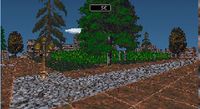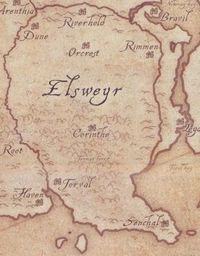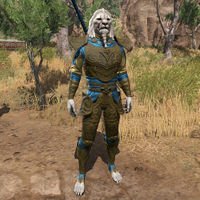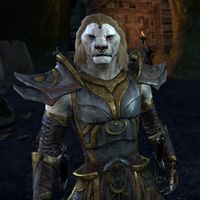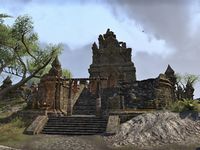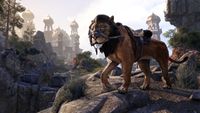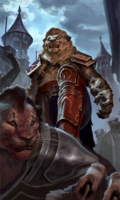Lore:Torval
This article is about the city. For the person also named Torval, see Topal the Pilot.
| Torval | |
|---|---|
| Type | Settlement |
| Continent | Tamriel |
| Province | Elsweyr |
| Region | Pellitine (Tenmar Forest) |
| Demonym(s) | Torvali[1] |
| Appears in | Arena |
Torval is one of the eight major cities in the province of Elsweyr,[2] and is situated in the dense jungles of the Tenmar Forest. Torval is the seat of power for the Mane, the spiritual and temporal leader of the Khajiit. Their tribe lives with them in exotic palaces and symmetrical moon sugarcane gardens.[3] The city has a long history associated with the Mane, going back to its time as one of the sixteen kingdoms.[4] In modern-day, Torval is known for its southern wines.[5]
Layout and Geography[edit]
Torval is located on the southwestern corner of Elsweyr,[6] near the Valenwood border, which is only a few hundred miles away.[3] It is part of the Kingdom of Pellitine,[6][7] the southern region of Elsweyr that is defined by its jungles and rainforests.[3] The Torval region has a damp climate[7] and the earth around the city contains ochre, a natural clay earth pigment. Torval Royal Ochre, in particular, is a rare and valuable dye.[8] The Mane and their tribe live in large stately palaces made from massive timber from Valenwood oak. Around these palaces are symmetrical sugarcane gardens, where the Mane often meditates in his palanquin.[3] Torval is neighbored by several settlements, including Darvulk Haven to the far southeast, Portneu View to the northeast, and Valenwood to the west,[2] toward Cormeir Spring and Haven.[9]
Notable Locales[edit]
- Asylum[10]
- Palace of the Mane[11]
- Temple of Two-Moons Dance[12]
History[edit]
Early History[edit]
Like the other sixteen kingdoms of ancient Elsweyr, Torval started as one of the original clans of nomadic Khajiit, all of whom excelled in a trade or discipline and swore fealty to the Moon-Emperor.[4][13] Torval was defined by its worship of the Mane.[4][14] As these clans mastered their roles, they pushed themselves into defined geographical areas and the concept of tribal regions was established from there. This is how the idea of sixteen kingdoms came to fruition.[13] Before they were full-fledged kingdoms, however, they were petty fiefdoms ruled by a cruel hunter-aristocracy helmed by the Hunt-Lords.[15]
The Merethic Era was a tumultuous time for the Khajiit as their society was at the heel of these Hunt-Lords. The Temples of Two-Moons Dance were the only ones to check them as Khajiiti adepts and Torval clergies held significant cultural influence. Despite the Hunt-Lords' attempt to oppress the people, their efforts were proven futile as the Khajiit developed the modern-day Claw-Dances and rebelled. Over the course of a thousand years, the hunter's caste system was abolished all over ancient Elsweyr and these fiefdoms became kingdoms.[15] Throughout history, these people lived in harmony among each other and their dominance was determined by the phases of the moons. When the moons were both halves, Torval was at its peak in power.[16]
In 1E 2200,[17] the Thrassian Plague led to the dissolution of the sixteen kingdoms, including Torval.[13] The clans of the south gathered in Senchal to the east, where the Khajiit were already able to adapt and the moon-priests of the Pa'alatiin Clan guiding them through the hardship. With Senchal as their capital, southern Elsweyr became known as the Kingdom of Pellitine and distinguished themselves from the nomads of the north.[18]
Torval in the Second Era[edit]
In the mid-Second Era, the Mane was Akkhuz-ri and his advisor, the Speaker of the Mane was Lord Gharesh-ri, both of whom had known each other since childhood.[19] In 2E 560, the Knahaten Flu had broken out from Black Marsh[20] and five years later, had reached Elsweyr, specifically Senchal.[21]
It did not take long for the flu to spread all over Elsweyr, including Torval. As people across the province slowly found ways to mitigate the disease, Lord Gharesh-ri assembled what was left of the Mane's Legion to maintain order and use their knowledge to the people's benefit. Queen Ayrenn offered assistance to the Khajiit and in order to fight a common enemy, both factions decided to come together.[20]
Akkhuz-ri and Gharesh-ri were present in 2E 580 when the signing of the Elden Accord took place between leaders of the First Aldmeri Dominion.[22] Gharesh-ri signed the Elden Accord and thus established Elsweyr as a member of the trans-provincial alliance.[19] He became a member of the Thalmor Inner Council; advisors that Queen Ayrenn had the utmost trust in.[23] Meanwhile, other members of the Thalmor were figureheads,[UOL 1] such as Lady Radurra-dra of Torval, who represented southwestern Elsweyr.[24]
Two years later in 2E 582, Akkhuz-ri became possessed by the Dark Mane and rampaged across Reaper's March to the north. When the two were separated in Arenthia, Akkhuz-ri relinquished his title as Mane and left it between the twins, Khali and Shazah. One of the twins became the new Mane in the Temple of the Dance in Dune, while the other took on the immortal task of bearing the Dark Mane's mantle and sealed away in Moonmont.[25] In 2E 864, the Mane was Nhad-hatta, who ruled during Tiber Septim's conquests of the late Second Era. An Imperial diplomat arranged a meeting with the Mane in his palace in Torval but was denied entry by the guards.[3]
Torval in the Third Era[edit]
By around 3E 80, Torval underwent a rebellion,[26] one of many that plagued Emperor Uriel Septim II's reign.[27] He brokered a deal with the King of Solitude at the time, Mantiarco who donated millions of gold in exchange for a bride, thus establishing an alliance with the Septim Dynasty. The Emperor agreed and the money was used to quell the rebellion in Torval.[26] Later in time, Uriel II's great-grandson, Pelagius III was moved across Tamriel to different healing institutions and asylums to relieve him of his madness.[28] The Emperor's visit to the asylum in Torval was adapted into a story written by the famed author Waughin Jarth called "The Asylum Ball". Pelagius III decides to hold a lavish ball in the asylum, and the old compound became a beautifully decorated ballroom with an orchestra in the pit. After the event, Pelagius III was moved to another location in Black Marsh and reportedly died three months later[10] in 3E 153.[28]
During the Imperial Simulacrum in the late Third Era, the city-state of Torval was an active settlement. It was ruled by King Mojtabe and had a rivalry with Corinth.[5] These ten years were marked with conflicts between the provinces, and Elsweyr was caught amidst the Five Year War against Valenwood to the west. How this event started is up to debate but the Khajiit felt it began with the so-called Slaughter of Torval, where the Bosmer invaded the city and killed thousands, only to fall back after Khajiiti reinforcements intervened.[29] In a map of capital cities across the provinces circa 3E 427, Torval is listed among them in Elsweyr.[30]
Known Rulers[edit]
The Sacred Mane of Torval
Servants of hirsute majesty
The loyal guards of Torval
—Excerpt from "The Sixteen Kingdoms"
- For a list of Manes, see the "previous manes" section in the following article: Mane.
For the longest time, Torval was ruled by a religious figure known as the Mane.[3] While Rid-Thar-ri'Datta is acknowledged as the first Mane,[31] that title has long been associated with Torval since its time as one of the sixteen kingdoms.[4] In the traditional Khajiiti child's chant, The Sixteen Kingdoms, Torval's ruler is referred to as the Sacred Mane of Torval.[4] By the Third Era, Torval was ruled by a King/Queen.[5]
The Mane employs an advisor and political representative called the Speaker of the Mane, who governs in their stead.[31] The Mane is also guarded by an elite force of Khajiiti warriors called the Bi-Lunar Guard, who mount themselves on Black Mane lions[11] and heavily guard the main premises.[3]
Culture and Society[edit]
The Temple of Two-Moons Dance in Torval is considered the best place in Tamriel to train in hand-to-hand combat and its masters have taught people from all over the Empire. They teach everything from ancient to modern techniques and their students have gone on to achieve great fame. One such example was Taren Omothan,[12] a monk and master trainer who took residence in Holamayan in 3E 427.[33] When the time came for students to graduate and move on from the temple, a grand festival of celebration commences, in which debates and competitions are held.[12]
The Torval Curiata is an order that administrates the temples across Elsweyr.[34][35] In Torval, the people use ritual incense burners made out of bronze and with moon-sugar canes.[36] Although Torval is known for wines,[5] other brands of alcohol are exported from the city, such as brandy,[37] and mead.[1] There is an active market in Torval and nearby Senchal for relics from the Anequine Conquests, especially artifacts from Darloc Brae's time.[38] By the waning years of the Third Era, the Gold Cat of Senchal, Ya'Tirrje had a drug-smuggling business in Torval, among other noteworthy cities.[16]
Gallery[edit]
Notes[edit]
- The name "Torval" is an alternate name for Topal the Pilot,[39] the Aldmeri explorer who fully charted the sea lanes of Tamriel. He was active in the late Merethic Era, when he first documented the "cat demons" which are speculated to be the ancient Khajiit.[40] It is possible that the city of Torval was named after Topal the Pilot.
- Arena was originally conceived as a fighting game featuring a tournament that took the player to each of Tamriel's cities to challenge different gladiatorial teams. According to a file from that stage of development left behind in the final game, Torval's gladiatorial team would have been called "the Firedrakes".[UOL 2]
See Also[edit]
- For game-specific information, see the Arena article.
Books[edit]
- The Sixteen Kingdoms — A traditional chant about the sixteen kingdoms of ancient Elsweyr
References[edit]
- ^ a b Feyfolken II — Waughin Jarth
- ^ a b Map of Elsweyr – The Elder Scrolls: Arena
- ^ a b c d e f g Pocket Guide to the Empire, 1st Edition: The Elsweyr Confederacy — Imperial Geographical Society, 2E 864
- ^ a b c d e The Sixteen Kingdoms
- ^ a b c d e Torval location and rumors in Arena
- ^ a b Map of Elsweyr – Pocket Guide to the Empire (1st Edition)
- ^ a b Crafting Motif 74: Pellitine Style — Cashia Khrasaat-Plume, Envoy of the Mane, Torval
- ^ Ball of Royal Ochre Mohair Yarn contraband text in ESO
- ^ Map of Valenwood – The Elder Scrolls: Arena
- ^ a b The Asylum Ball — Waughin Jarth
- ^ a b Black Mane Lion mount description in ESO
- ^ a b c Master Zoaraym's Tale — Gi'Nanth
- ^ a b c Anequina and Pellitine: An Introduction — Sulema, Initiate Scholar of the Pa'alatiin
- ^ Song of Kingdoms
- ^ a b Origins of the Khajiiti Martial Tradition — Tendwuayne, Sapiarch of Foreign Customs
- ^ a b Pocket Guide to the Empire, 3rd Edition: Sugar and Blood: the Cats of the South — Imperial Geographical Society, 3E 432
- ^ Systres History: Volume 3 — Trilam Heladren, Associate Dean of Eltheric History, University of Gwylim
- ^ History of Pellitine: An Overview — Sulema, Initiate Scholar of the Pa'alatiin
- ^ a b Lord Gharesh-ri's dialogue in ESO
- ^ a b The Eagle and the Cat — Lord Gharesh-ri, Speaker for the Mane
- ^ History of Senchal: An Overview — Sulema, Initiate Scholar of the Pa'alatiin
- ^ Queen Ayrenn's dialogue during the quest, "The Moonlit Path" in ESO
- ^ Aicantar of Shimmerene Answers Your Questions — Aicantar of Shimmerene
- ^ Khajiiti Honorifics — Lady Radurra-dra of Torval
- ^ Reaper's March questline in ESO
- ^ a b The Wolf Queen, v1 — Waughin Jarth
- ^ Brief History of the Empire v 1 — Stronach k'Thojj III
- ^ a b Brief History of the Empire v 2 — Stronach k'Thojj III
- ^ Mixed Unit Tactics — Codus Callonus
- ^ Map of Tamriel – Morrowind Codex
- ^ a b Shazah's dialogue in ESO
- ^ The Improved Emperor's Guide to Tamriel: Elsweyr — Flaccus Terentius, 2E 581
- ^ Taren Omothan in Morrowind
- ^ Letter to Abbot Kulan-dro — Bishop Valnargo-dro
- ^ Adara'hai's dialogue in ESO: Thieves Guild
- ^ Torval Ritual Censer contraband text in ESO
- ^ Torval Brandy quest item in ESO: Dragonhold
- ^ Kuna's Delve loading screen text in ESO
- ^ Decentius Opsius' dialogue in Oblivion
- ^ Father of the Niben — Florin Jaliil
Note: The following references are considered to be unofficial sources. They are included to round off this article and may not be authoritative or conclusive.
